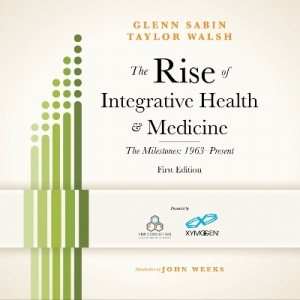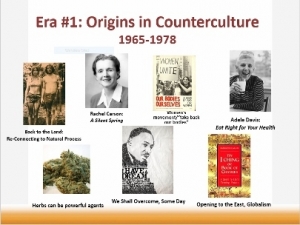Free e-book discusses the rise of integrative health and medicine
November 22, 2016
 by John Weeks, Publisher/Editor of The Integrator Blog News and Reports
by John Weeks, Publisher/Editor of The Integrator Blog News and Reports At what point can an emergent movement look back and claim a history? And what is that history if, over the course of the time chronicled, separate strands have knit together into a whole that was unimagined at the outset? Do the lineages of each become the shared ancestry of what is emerging?These are the opening lines of what is effectively the first written “history” of the movement of integrative health and medicine. I put “history” in quotation marks because what is presented in “Rise,” the 91-page e-book available for free via FON Consulting through a partnership with XYMOGEN, is not a thorough or dense history. Rather, “Rise” invites a pleasurable skim over an accessible series of 125 “milestones.” Each is a paragraph or two of text together with a portrait or logo. These mark the achievement of the institution, organization, or individual called out with links to more details.
 “Rise” is the brainchild of well-known integrative clinician, integrative oncology consultant, author and marketer, and FON’s founder, Glenn Sabin (pictured), who is also the author of N of 1, about his own cancer journey. The book was principally written by Taylor Walsh, a long-time writer and consultant in the field. I have a substantial alignment of interest with this project. The milestones themselves are significantly based on content documented in my own Integrator Blog News & Reports and in a presentation I gave on the history at the October 2015 People, Planet, Purpose conference hosted by the Academy of Integrative Health and Medicine (AIHM). Sabin asked me to write the introduction to “Rise.” The lines at the top of this column are the way I chose to open. In the months that this project has been in development, I had opportunities to refine my views of this history through presentations at the Integrative Healthcare Leadership Program at Duke University, the CAM Masters in Science at Georgetown University, the Integrative Medicine Scholars Program of the American Medical Students Association, and, again, at AIHM this year. I have come to view the movement in five eras that I examine in more detail in this article. Here they are, briefly.
“Rise” is the brainchild of well-known integrative clinician, integrative oncology consultant, author and marketer, and FON’s founder, Glenn Sabin (pictured), who is also the author of N of 1, about his own cancer journey. The book was principally written by Taylor Walsh, a long-time writer and consultant in the field. I have a substantial alignment of interest with this project. The milestones themselves are significantly based on content documented in my own Integrator Blog News & Reports and in a presentation I gave on the history at the October 2015 People, Planet, Purpose conference hosted by the Academy of Integrative Health and Medicine (AIHM). Sabin asked me to write the introduction to “Rise.” The lines at the top of this column are the way I chose to open. In the months that this project has been in development, I had opportunities to refine my views of this history through presentations at the Integrative Healthcare Leadership Program at Duke University, the CAM Masters in Science at Georgetown University, the Integrative Medicine Scholars Program of the American Medical Students Association, and, again, at AIHM this year. I have come to view the movement in five eras that I examine in more detail in this article. Here they are, briefly. - Era #1 (1963-1978): Origins in Counterculture. Milestones 1-9
- Era #2 (1979-1995): Advancing in Silos. Milestones 10-24
- Era #3 (1995-present): Non-Integrated Integration. Still working on this. Milestones 25-44
- Era #4 (2001-present): Advancing in Collaboration. Milestones 45-79
- Era #5 (2010-present): Convergence in Health Creation. Milestones 80-120
 The 125 milestones in “Rise” provide readers with a guided walk since the origins of the movement in the “cultural amniotic stew” of the 1960s. The tour passes through decades of steady formative work amidst disdain and restraint of trade from regular medicine. We move through a phase of “non-integrated integration” and into multiple emerging collaborations. Today, we see evidence of leadership by the movement amidst a convergence with efforts of progressive leaders of the dominant school of medicine to move from “volume to value” to shift the reactive medical industry toward a focus on creating health. The book as presented is a first iteration. Sabin invites additions from readers. What milestones were inadvertently left out? In a conversation with Sabin shortly after the release, he shared that he is hoping to have an update out in six months to capture the most important “missing pieces” from this first offering. Then, he anticipates an update every second year. Comment The fundamental value that Sabin, Walsh and XYMOGEN have created with “Rise” is to help dispel a curse. The 20th century German philosopher Walter Benjamin famously said, “History is written by the victors.” The implication is that such history is re-written and re-shaped by those in power. Yet, in order to be rewritten, a history needs first to be written. In order to prevail as an important cultural story and transformative influence, the contributing tributaries to this movement must be seen as the rivering influence that they have become. “Rise” begins to tell this story, and does so in a very approachable way. Perhaps the most important value of this e-book is that, as the milestones indicate, the movement for integrative health and medicine is stronger the more that distinct elements see themselves as connected and move in collaboration. To know and claim a shared history may launch the movement toward greater effectiveness. Spread this tool around. Suggest your changes. Own the history.
The 125 milestones in “Rise” provide readers with a guided walk since the origins of the movement in the “cultural amniotic stew” of the 1960s. The tour passes through decades of steady formative work amidst disdain and restraint of trade from regular medicine. We move through a phase of “non-integrated integration” and into multiple emerging collaborations. Today, we see evidence of leadership by the movement amidst a convergence with efforts of progressive leaders of the dominant school of medicine to move from “volume to value” to shift the reactive medical industry toward a focus on creating health. The book as presented is a first iteration. Sabin invites additions from readers. What milestones were inadvertently left out? In a conversation with Sabin shortly after the release, he shared that he is hoping to have an update out in six months to capture the most important “missing pieces” from this first offering. Then, he anticipates an update every second year. Comment The fundamental value that Sabin, Walsh and XYMOGEN have created with “Rise” is to help dispel a curse. The 20th century German philosopher Walter Benjamin famously said, “History is written by the victors.” The implication is that such history is re-written and re-shaped by those in power. Yet, in order to be rewritten, a history needs first to be written. In order to prevail as an important cultural story and transformative influence, the contributing tributaries to this movement must be seen as the rivering influence that they have become. “Rise” begins to tell this story, and does so in a very approachable way. Perhaps the most important value of this e-book is that, as the milestones indicate, the movement for integrative health and medicine is stronger the more that distinct elements see themselves as connected and move in collaboration. To know and claim a shared history may launch the movement toward greater effectiveness. Spread this tool around. Suggest your changes. Own the history.



















SHARE